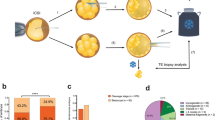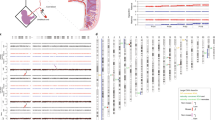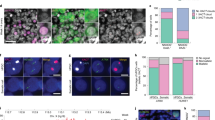Abstract
In mice, parthenogenetic embryos die at the early postimplantation stage as a result of developmental requirements for paternally imprinted genes, particularly for formation of extraembryonic tissues. Chimaeric parthenogenetic↔normal mice are viable, however, due to non–random differences in distribution of their two cell types. Species differences in imprinting patterns in embryo and extra–embryonic tissues mean that there are uncertainties in extrapolating these experimental studies to humans. Here, however, we demonstrate that parthenogenetic chimaerism can indeed result in viable human offspring, and suggest possible mechanisms of origin for this presumably rare event.
This is a preview of subscription content, access via your institution
Access options
Subscribe to this journal
Receive 12 print issues and online access
$209.00 per year
only $17.42 per issue
Buy this article
- Purchase on Springer Link
- Instant access to full article PDF
Prices may be subject to local taxes which are calculated during checkout
Similar content being viewed by others
References
Linder, D. & Power, J. Further evidence for post-meiotic origin of teratomas in the human female. Ann. hum. Genet. 34, 21–30 (1970).
Surani, M.A., Barton, S.C. & Morris, M.L. Development of reconstituted mouse eggs suggests imprinting of the genome during gametogenesis. Nature 308, 548–550 (1984).
McGrath, J. & Solter, D. Completion of mouse embryogenesis requires both the maternal and paternal genomes. Cell 37, 179–183 (1984).
Stevens, L.C., Vamum, D.S. & Eicher, E.M. Viable chimaeras produced from normal and parthenogenetic mouse embryos. Nature 269, 515–517 (1977).
Surani, M.A., Barton, S.C. & Kaufman, M.H. Development to term of chimaeras between diploid parthenogenetic and fertilised embryos. Nature 270, 601–603 (1978).
Nagy, A., Sass, M. & Markkula, M. Systematic non-uniform distribution of parthenogenetic cells in adult mouse chimaeras. Development 108, 321–324 (1989).
Fundele, R., Morris, M.L., Barton, S.C., Reik, W. & Surani, M.A. Systematic elimination of parthenogenetic cells in mouse chimeras. Development 106, 29–35 (1989).
Clarke, H.J., Varmuza, S., Prideaux, V.R. & Rossant, J. The developmental potential of parthenogenetically derived cells in chimeric mouse embryos: implications for action of imprinted genes. Development 104, 175–182 (1988).
Thomson, J.A. & Solter, D. Chimeras between parthenogenetic or androgenetic blastomeres and normal embryos: allocation to the inner cell mass and trophectoderm. Dev. Biol. 131, 580–583 (1989).
Thomson, J.A. & Solter, D. The developmental fate of androgenetic, parthenogenetic, and gynogenetic cells in chimeric gastrulating mouse embryos. Genes Devel. 2, 1344–1351 (1988).
Nagy, A., Paldi, A., Dezso, L., Varga, L. & Magyar, A. Prenatal fate of parthenogenetic cells in mouse aggregation chimaeras. Development 101, 67–71 (1987).
Burk, R.D., Ma, P. & Smith, K. Characterization and evolution of a single-copy sequence from the human Y chromosome. Molec. cell. Biol. 5, 576–581 (1985).
Willard, H.F., Smith, K.D. & Sutherland, J. Isolation and characterization of a major tandem repeat family from the human X chromosome. Nucl. Acids Res. 11, 2017–2033 (1983).
MacDonald, M. et al. The origin of 47.XXY and 47.XXX aneuploidy: heterogeneous mechanisms and role of aberrant recombination. Hum. molec. Genet. 3, 1365–1371 (1994).
Fisher, J.M., Harvey, J.F., Morton, N.E. & Jacobs, P.A. Trisomy 18: studies of the parent and cell division of origin and the effect of aberrant recombination on nondisjunction. Am. J. hum. Genet. 56, 669–675 (1995).
Parrington, J.M., West, L.F. & Povey, S. The origin of human teratomas. J. med. Genet. 21, 4–12 (1984).
Maleszewski, M. & Bielak, A. Sperm penetration in parthenogenetic mouse embryos triggers a plasma membrane block to polyspermy. Zygote 1, 237–242 (1993).
Maleszewski, M. Behavior of sperm nuclei incorporated into parthenogenetic mouse eggs prior to the first cleavage division. Molec. Reprod. Dev. 33, 215–221 (1992).
Ogawa, M. et al. Expression and function of c-Kit in fetal hemopoietic progenitor cells: transition from the early c-Kit-independent to the late c-Kit-dependent wave of hemopoiesis in the murine embryo. Devlopment 117, 1089–1098 (1993).
McLaren, A. Sex chimaerism and germ cell distribution in a series of chimaeric mice. J. Embryol. exp. Morphol. 33, 205–216 (1975).
Ellis, N. et al. Population structure of the human pseudoautosomal boundary. Nature 344, 663–665 (1990).
Strain, L. et al. Prenatal diagnosis of fragile X syndrome: management of the male fetus with a premutation. Prenat. Diag. 14, 469–474 (1994).
Fantes, J.A. et al. Submicroscopic deletions at the WAGR locus, revealed by nonradioactive in situ hybridization. Am. J. hum. Genet. 51, 1286–1294 (1992).
Author information
Authors and Affiliations
Rights and permissions
About this article
Cite this article
Strain, L., Warner, J., Johnston, T. et al. A human parthenogenetic chimaera. Nat Genet 11, 164–169 (1995). https://doi.org/10.1038/ng1095-164
Received:
Accepted:
Issue Date:
DOI: https://doi.org/10.1038/ng1095-164
This article is cited by
-
Parental genomes segregate into distinct blastomeres during multipolar zygotic divisions leading to mixoploid and chimeric blastocysts
Genome Biology (2022)
-
Parthenogenetic mosaicism: generation via second polar body retention and unmasking of a likely causative PER2 variant for hypersomnia
Clinical Epigenetics (2021)
-
A case of 46,XX/46,XX chimerism in a phenotypically normal woman
International Journal of Legal Medicine (2020)
-
Genome-wide uniparental diploidy of all paternal chromosomes in an 11-year-old girl with deafness and without malignancy
Journal of Human Genetics (2018)
-
Mosaic genome-wide maternal isodiploidy: an extreme form of imprinting disorder presenting as prenatal diagnostic challenge
Clinical Epigenetics (2017)



